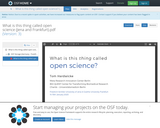
A general introduction to open scholarship.
- Subject:
- Applied Science
- Life Science
- Physical Science
- Social Science
- Material Type:
- Lesson
- Provider:
- METRICS
- Author:
- Tom Hardwicke
- Date Added:
- 01/13/2020

A general introduction to open scholarship.

Climate justice recognizes the responsibility of the wealthy for climate change, which disproportionately impacts the vulnerable. Urban climate action plans are increasingly addressing justice, but some cities still lack such plans. Larger cities tend to prioritize justice more, and sectors like energy efficiency and clean energy receive greater attention. More efforts are needed to achieve just and inclusive urban climate transitions.

This activity engages students in a role play to negotiate an agreement between the United States and China about climate change policies. Students use given background material or can do their own additional research to present their assigned stakeholder's position in a simulated negotiation.

The Inflation Reduction Act (IRA) is the largest-ever federal program focused on energy and the environment, allocating $369 billion over a decade. With a laser focus on climate change, the IRA aims to cut greenhouse gas emissions, promote clean energy, and enhance climate resilience. Its provisions have the potential to create jobs, lower electricity costs, and significantly contribute to meeting the US climate targets.

The course introduces the main debates about the “new” global economy and their implications for practice and policy. Experts from academia and business will share their findings about, and direct experiences with, different aspects of globalization.
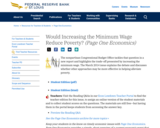
The nonpartisan Congressional Budget Office tackles that question in a new report and highlights the trade-off presented by increasing the minimum wage. The March 2014 issue explains the debate and discusses whether other approaches may be more effective in helping alleviate poverty.
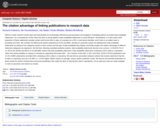
Efforts to make research results open and reproducible are increasingly reflected by journal policies encouraging or mandating authors to provide data availability statements. As a consequence of this, there has been a strong uptake of data availability statements in recent literature. Nevertheless, it is still unclear what proportion of these statements actually contain well-formed links to data, for example via a URL or permanent identifier, and if there is an added value in providing them. We consider 531,889 journal articles published by PLOS and BMC which are part of the PubMed Open Access collection, categorize their data availability statements according to their content and analyze the citation advantage of different statement categories via regression. We find that, following mandated publisher policies, data availability statements have become common by now, yet statements containing a link to a repository are still just a fraction of the total. We also find that articles with these statements, in particular, can have up to 25.36% higher citation impact on average: an encouraging result for all publishers and authors who make the effort of sharing their data. All our data and code are made available in order to reproduce and extend our results.
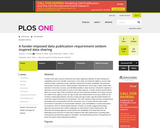
Growth of the open science movement has drawn significant attention to data sharing and availability across the scientific community. In this study, we tested the ability to recover data collected under a particular funder-imposed requirement of public availability. We assessed overall data recovery success, tested whether characteristics of the data or data creator were indicators of recovery success, and identified hurdles to data recovery. Overall the majority of data were not recovered (26% recovery of 315 data projects), a similar result to journal-driven efforts to recover data. Field of research was the most important indicator of recovery success, but neither home agency sector nor age of data were determinants of recovery. While we did not find a relationship between recovery of data and age of data, age did predict whether we could find contact information for the grantee. The main hurdles to data recovery included those associated with communication with the researcher; loss of contact with the data creator accounted for half (50%) of unrecoverable datasets, and unavailability of contact information accounted for 35% of unrecoverable datasets. Overall, our results suggest that funding agencies and journals face similar challenges to enforcement of data requirements. We advocate that funding agencies could improve the availability of the data they fund by dedicating more resources to enforcing compliance with data requirements, providing data-sharing tools and technical support to awardees, and administering stricter consequences for those who ignore data sharing preconditions.

This resource is a video abstract of a research paper created by Research Square on behalf of its authors. It provides a synopsis that's easy to understand, and can be used to introduce the topics it covers to students, researchers, and the general public. The video's transcript is also provided in full, with a portion provided below for preview:
"Economic globalization and inequality are spreading fast sparking interest in global value chains among both academics and policy makers For decades, the Heckscher-Ohlin model was the only method for understanding these phenomena Conflicting empirical evidence has led to a surge of theoretical models describing international trade scenarios This disjointed knowledge has made navigating the economic literature a difficult task Now, a new visual tool could help even non-specialists piece all of the evidence together in one place Using simple supply and demand diagrams, this tool offers unprecedented explanatory power Making it quick and easy for professionals and students alike to spot where popular models overlap or vary While it currently covers only neoclassical trade models... This figure is a powerful tool that could be used by virtually anyone to understand the effects of global value chains on inequality Franssen, L. (2019)..."
The rest of the transcript, along with a link to the research itself, is available on the resource itself.
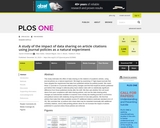
This study estimates the effect of data sharing on the citations of academic articles, using journal policies as a natural experiment. We begin by examining 17 high-impact journals that have adopted the requirement that data from published articles be publicly posted. We match these 17 journals to 13 journals without policy changes and find that empirical articles published just before their change in editorial policy have citation rates with no statistically significant difference from those published shortly after the shift. We then ask whether this null result stems from poor compliance with data sharing policies, and use the data sharing policy changes as instrumental variables to examine more closely two leading journals in economics and political science with relatively strong enforcement of new data policies. We find that articles that make their data available receive 97 additional citations (estimate standard error of 34). We conclude that: a) authors who share data may be rewarded eventually with additional scholarly citations, and b) data-posting policies alone do not increase the impact of articles published in a journal unless those policies are enforced.

في هذه الوحدة، سنقدم وصفًا شاملًا للمشهد القانوني للتكنولوجيا المساعدة على المستوى المحلي والدولي، بالإضافة إلى أفضل الممارسات المتبعة في هذا المجال